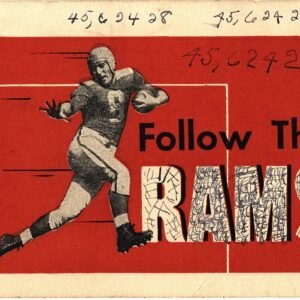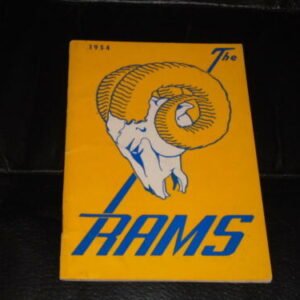The 1968 Los Angeles Rams had a 9–4–1 record, which was a strong performance, but it still wasn’t enough to get them into the playoffs. This season marked a turning point as the Rams showed significant progress and established themselves as a competitive team in the NFL. However, despite their solid record, they fell short in the highly competitive NFL Western Conference.















Here’s a closer look at their 1968 season:
Team Overview:
- The 1968 Rams were coached by Harland Svare, who had been with the team since 1960. It was his last season as head coach of the Rams.
- They played their home games at the Los Angeles Memorial Coliseum.
- The Fearsome Foursome defensive line (Deacon Jones, Merlin Olsen, Rosie Grier, and Lamar Lundy) was still one of the best in the NFL, continuing to be the team’s strength. The defense was elite, and the Rams continued to dominate opponents on that side of the ball.
- Roman Gabriel was becoming the team’s starting quarterback, showing promise as the future leader of the franchise.
Performance:
- Record: The Rams finished with a 9–4–1 record, placing them 2nd in the NFL Western Conference behind the Green Bay Packers, who won the conference title with a 9-4-1 record but held the tiebreaker.
- The Rams’ 9–4–1 record was strong, but they were unable to make the playoffs, as only the conference champion advanced to the postseason.
- Their offense was still developing, with Roman Gabriel making strides as the quarterback, but the team’s lack of consistency on that side of the ball prevented them from being a complete contender.
Key Players:
- Roman Gabriel: In his second year as the starting quarterback, Roman Gabriel showed great promise. He led the Rams with improved play under center, developing into a top-tier NFL quarterback. Gabriel would go on to become the face of the Rams’ offense in the following years.
- Deacon Jones: Jones was a key figure on the Rams’ defense, earning his fourth consecutive Pro Bowl selection. His play as a pass rusher was still one of the best in the league, and he finished the season with 18 sacks, continuing his reputation as one of the most feared defensive players in NFL history.
- Merlin Olsen: Olsen was still one of the most dominant interior defensive linemen in the NFL. He earned another Pro Bowl selection in 1968, continuing his development as a Hall of Fame-caliber player.
- Rosie Grier: Grier remained a powerful force along the defensive line and was an integral part of the Rams’ defensive success. He helped to make the Fearsome Foursome one of the best and most feared defensive lines of all time.
- Lamar Lundy: Lundy, the fourth member of the Fearsome Foursome, contributed significantly to the defensive line, making it one of the most dominant in NFL history.
- Tom Fears: Fears was still an important veteran presence for the team but was past his prime. He provided leadership to the younger players and continued to contribute on offense.
- Elroy “Crazylegs” Hirsch: Like Fears, Hirsch was past his prime, but his experience was still valuable to the Rams’ offense.
Notable Events:
- Quarterback development: While Roman Gabriel still had his struggles, he showed marked improvement in 1968. His growth as the Rams’ starting quarterback was a key part of the team’s future success. Despite his developing play, the Rams’ offense remained inconsistent, with the team relying heavily on their defense.
- Defensive dominance: The Fearsome Foursome continued to dominate opposing offenses, making life difficult for quarterbacks with their pass rush and run defense. Deacon Jones was particularly dominant, earning another Pro Bowl selection and finishing the season with 18 sacks.
- Missed playoff berth: The Rams’ 9–4–1 record was impressive, but they finished in 2nd place in the NFL Western Conference, tied with the Green Bay Packers but losing the tiebreaker. As a result, the Rams were once again denied a playoff spot, despite having one of the best records in the league.
Legacy:
- The 1968 season marked the end of Harland Svare’s tenure as head coach of the Rams. Despite the team’s strong defense, Svare struggled to make the necessary changes on offense to push the Rams into the playoffs.
- The Fearsome Foursome continued to solidify its place in NFL history as one of the most dominant defensive lines ever. They were a major reason why the Rams were competitive throughout the season.
- Roman Gabriel’s development as the starting quarterback was one of the key positives of the season, and he would go on to lead the Rams in the years to come, eventually becoming a star in the early 1970s.
- Despite finishing with a strong record, the Rams were once again kept out of the playoffs, which would continue to be a source of frustration for the team and their fans in the late 1960s.
- 1968 also marked a year of transition, as the Rams began to develop younger talent, with Roman Gabriel taking on a more prominent role at quarterback. The team was poised for future success in the 1970s, with Gabriel at the helm and the defensive line still dominating.
The 1968 Los Angeles Rams were a competitive team with one of the best defenses in the NFL. While they showed promise, especially with the development of Roman Gabriel, their lack of offensive consistency kept them from breaking through into the playoffs. However, the future was bright for the Rams, as they were positioned for greater success in the coming years with Gabriel at quarterback and their legendary defense intact.
Head Coach: *George Allen
|





